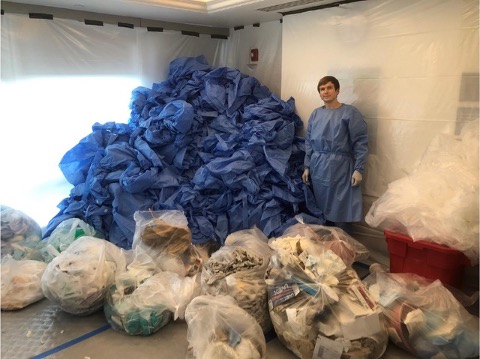Centered on Sustainability: Every Day is Earth Day at MGH
Jonathan Slutzman, MD, director of the MGH Center for the Environment and Health, discusses sustainability efforts across Massachusetts General Hospital.
News5 Minute ReadFeb | 23 | 2022
The MGH Institute of Health Professions Center for Climate Change, Climate Justice and Health hosted its latest Grand Rounds webinar, “Inpatient Medicine Waste Audit and the Plastic Pandemic,” co-sponsored by the MGH Center for the Environment and Health, Feb. 16. Sustainability leaders from across the MGH discussed the COVID-19 pandemic’s impact on inpatient medicine waste production, as well as the results of the hospital’s August 2021 waste audit.
The United States is currently the largest generator of plastic waste in the world, with the health care industry alone producing an estimated 5 million tons of waste each year and nearly 10% of the country’s overall greenhouse gas emissions.
“As health care providers, we should be particularly concerned about the consequences of the care we deliver and how it impacts public health,” said Christian Mewaldt, MD, associate at the MGH Center for Environment and Health. “Unfortunately, plastic affects our health at both ends of its lifecycle – the production side and the waste side.”
Mewaldt used “Cancer Alley” as an example of how destructive plastic production can be. This long stretch of land along the Mississippi River between Baton Rouge and New Orleans is home to a high concentration of plastic production facilities. Residents are exposed to some of the highest concentrations of cancer-causing chemicals in the country, leading the United Nations Human Rights Council to describe the area as an example of environmental racism.
“It’s a heavily African American community,” Mewaldt said. “Communities and people of color are being increasingly utilized to place these facilities.”
As for the waste side of plastic’s 450-year lifecycle, Mewaldt estimates only 9% of plastic waste is actually recycled. Materials that aren’t recycled end up in landfills, degrading into methane and ethyne and contaminating water supplies. Since the start of the COVID-19 pandemic, plastic waste production has risen around the world.
To assess the MGH’s plastic waste production during the pandemic, Jon Eisen, MD, associate at the MGH Center for the Environment and Health, reviewed the results of the August inpatient medicine unit waste audit. Waste audits are used to quantify and characterize waste generated in a particular setting. They also help to identify pathways for improvement in waste generation, diversion and elimination.
“When thinking about our waste, medicine units are the backbone of patient care,” Eisen said. “We see a high volume of patients, so it would make sense that we generate a lot of waste in that process.”
To complete the audit, waste from Phillips 21 was collected and sorted over a 24-hour period and stored in the on-floor solarium. It was then weighed, transported to a second holding room and disposed of by Environmental Services.
Finally, the total mass and distribution of waste was quantified, and items of interest were cataloged, weighed and tallied. In total, 559 plastic gowns, 2,541 plastic gloves, 86 masks and 20 face shields/goggles were counted.
“Going through the results of our audit, we found we had accumulated close to 300 pounds of waste in a 24-hour period in Phillips 21,” Eisen said. “Nearly 90% of that waste was municipal solid waste. More than half of the municipal solid waste was plastic, and 70% of that plastic was PPE.”
This audit alone accounted for close to 0.537 metric tons of greenhouse gas emissions, which is equivalent to burning 594 pounds of coal or charging 65,322 smartphones.
Looking ahead at ways to reduce the hospital’s waste, Mewaldt suggested eliminating single-use plastic toiletries, transitioning from disposable gowns to reusable ones and composting more food waste.
“The MGH has successfully implemented a number of waste reduction measures in the past,” Mewaldt said. “If we were to take some of these next steps, we could improve the hospital’s waste production even more.”
Jonathan Slutzman, MD, director of the MGH Center for the Environment and Health, discusses sustainability efforts across Massachusetts General Hospital.
When Earth Day comes around each spring, people often look to the “three Rs” for ways to help the environment – reduce, reuse and recycle. Climate experts emphasize that while these three actions are a great place to start, it requires action beyond Earth Day to make a long-lasting impact.
